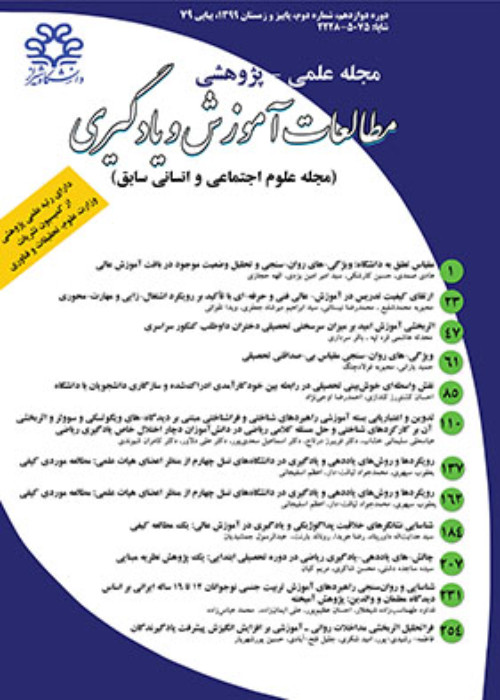A Survey on Adoption of Electronic Reference Materials in Iranian Central Academic Libraries Based on
Author(s):
Abstract:
IntroductionElectronic Reference sources are one of the most important information resources which have affected libraries environment. Enjoying the support of the Ministry of Science, Research and Technology, academic libraries have been more successful in using to use electronic resources. This paper aimed to study the process of diffusion of electronic reference resources as a familiar innovation among Iranian academic libraries.Rogers diffusion of innovations theory is selected as the theoretical framework for this research. “In this theory diffusion is defined as a process by which an innovation is communicated through certain channels over time among the members of a social system. The process is categorized into four steps (stages) known as: knowledge, persuasion, decision, and confirmation (Holland, 2007).”MethodA survey method was used to carry out this study. Data were collected by a structured questionnaire. To measure the validity of the research tool the questionnaire was reviewed by academic staff of the Department of Library and Information Science and College of Education and Psychology of Shiraz University, Iran. The reliability of the questionnaire was measured by carrying out a test and a retest. The Pearson Correlation test showed a number equal to 0.998 which meant that the research tool was highly reliable. Questionnaires were sent to academic libraries to be filled by reference librarians or library managers.DiscussionAs stated in Roger's theory, the adopter libraries were categorized into three groups according to the time of adoption the electronic reference resources. The three groups are innovators (pioneers), conservatives (early adopters) and laggards. Results showed that the cumulative number of adopters of electronic reference resources follows a S-shaped curve as mentioned in Roger's theory. The number of adopters plotted as a frequency histogram against time follows a normal bell-shaped curve where the number of new adopters rises until halfway the S-curve after that their numbers decrease.In addition, the four steps of innovation-decision process mentioned in Roger's theory were distinguished among the academic libraries. The first step is knowledge, in which, adopters become aware of an innovation and get some idea of how it functions. The most important communicational channels for innovators and conservatives were congresses, seminars, and journals. However, the laggards did not use such channels. The second stage is persuasion, in which adopters are interested in the innovation and actively seek information about it. Therefore, they form a favorable or unfavorable attitude toward the innovation. The results showed that innovator libraries passed the persuasion stage with a completely positive attitude. However, the decrease in the interest of conservative and laggard libraries was obvious. The third stage is decision in which adopters engage in activities that weigh the advantages and disadvantages of using the innovation and decide whether to adopt or reject it. According to the Roger's theory, most adopters would not adopt an innovation without passing a trial period using the innovation. The results of this study showed that only half of academic libraries had experienced the trial use of electronic reference sources and others provided e-reference sources without passing this stage. Confirmation step is the fourth and last step of innovation decision process, in which adopters finalize their decisions to continue using the innovation and may use the innovation to its fullest potential. Expanding e-reference services is a sign of confirmation of the adoption of electronic reference resources among academic libraries. The results showed that more terminals were used for electronic reference services in innovator and conservative libraries. However, laggard libraries had some developments, too.ConclusionFinally, it is possible to say that innovator and conservative libraries were more successful in passing the four steps of innovation-decision process. However, it is impossible to say that electronic reference resources were replaced effectively for print resources due to various barriers such as lack of budget and inexperienced librarians.
Language:
Persian
Published:
Studies in Learning & Instruction, Volume:2 Issue: 1, 2011
Page:
95
magiran.com/p966254
دانلود و مطالعه متن این مقاله با یکی از روشهای زیر امکان پذیر است:
اشتراک شخصی
با عضویت و پرداخت آنلاین حق اشتراک یکساله به مبلغ 1,390,000ريال میتوانید 70 عنوان مطلب دانلود کنید!
اشتراک سازمانی
به کتابخانه دانشگاه یا محل کار خود پیشنهاد کنید تا اشتراک سازمانی این پایگاه را برای دسترسی نامحدود همه کاربران به متن مطالب تهیه نمایند!
توجه!
- حق عضویت دریافتی صرف حمایت از نشریات عضو و نگهداری، تکمیل و توسعه مگیران میشود.
- پرداخت حق اشتراک و دانلود مقالات اجازه بازنشر آن در سایر رسانههای چاپی و دیجیتال را به کاربر نمیدهد.
In order to view content subscription is required
Personal subscription
Subscribe magiran.com for 70 € euros via PayPal and download 70 articles during a year.
Organization subscription
Please contact us to subscribe your university or library for unlimited access!



